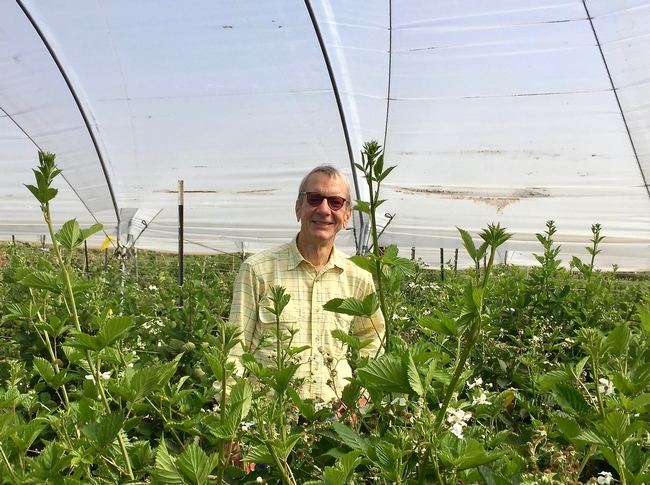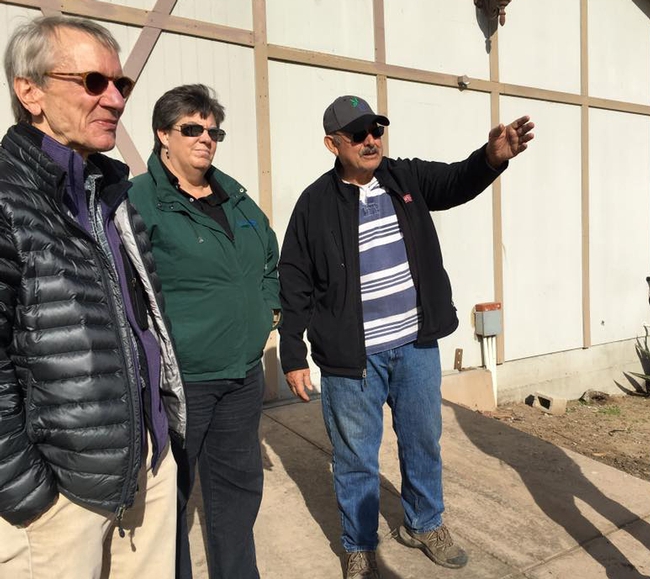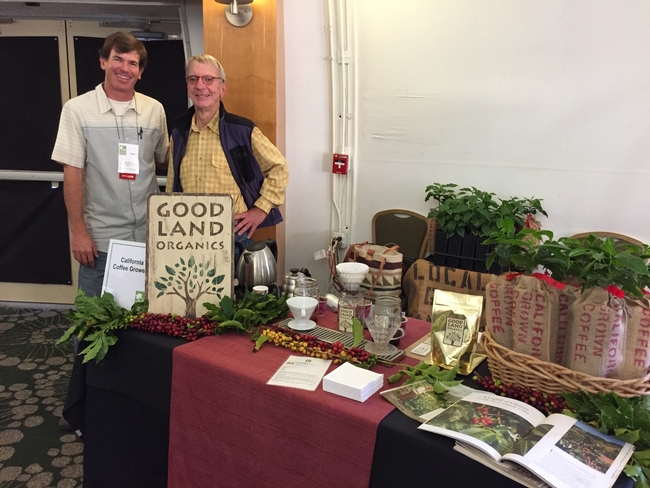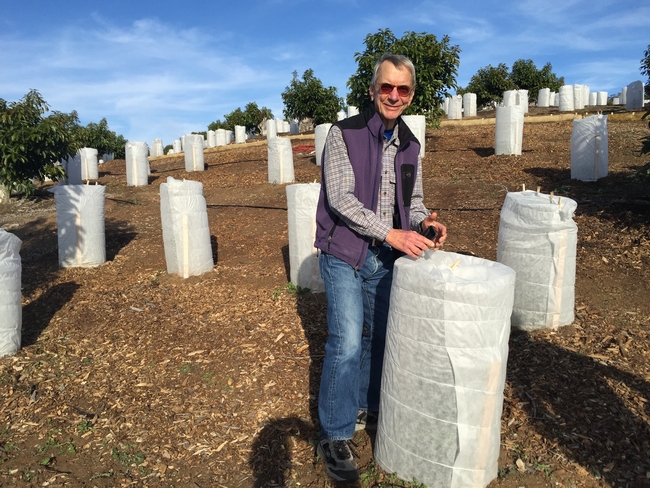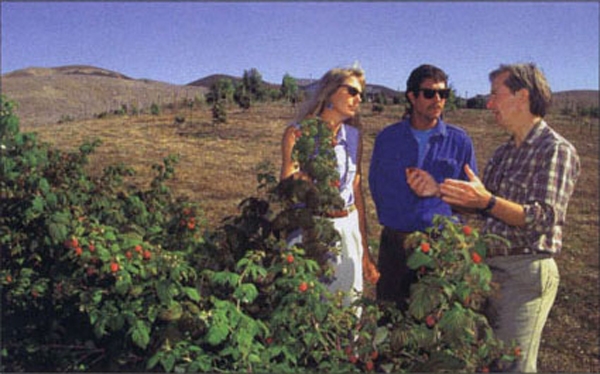Posts Tagged: blueberries
UCCE small farms advisor Mark Gaskell retires
Mark Gaskell is best known these days for cultivating the idea of California-grown coffee that launched the emerging industry. But coffee isn't the first crop that Gaskell convinced California farmers could be locally grown. For more than 23 years, the UC Cooperative Extension advisor has been researching new specialty crops, such as blueberries, blackberries, raspberries, kiwi berries, Pakistani mulberries, sweet onions, lychees and longans, for small farms to grow for a profit.
Gaskell, who began his career with the University of California's Division of Agriculture and Natural Resources as an advisor for small farms and specialty crops in San Luis Obispo and Santa Barbara counties in 1995, retired July 1.
Blueberries become a California crop
Blueberries weren't grown in California until Gaskell planted test plots of southern highbush blueberries in 1996 to give small-scale growers a new crop option. He hosted his first blueberry field day in 1998. In collaboration with UC Cooperative Extension advisors in other counties, Gaskell identified varieties suited to the local climate and developed cultural practices for California growers to successfully produce blueberries. What was once a niche crop is now planted on over 7,000 acres in the state, according to the California Blueberry Commission. California currently leads U.S. production of fresh blueberries, Gaskell said.
“If it wasn't for Mark Gaskell, I wouldn't have lasted three years,” said Tony Chavez, who grows 40 acres of blueberries, blackberries and some raspberries in Nipomo.
Chavez had grown bored after selling La Tapatia Norcal, a tortilla shop that he operated for 34 years, and retiring in San Luis Obispo County.
“After I retired, I started a little farm. I started with blackberries,” Chavez said. “I have friends who farm. I didn't realize it would be such hard work.”
Someone told Chavez that Gaskell helps small farmers. “He's been my teacher about how to grow berries. Everything I know about farming, I owe to Mark,” said Chavez, who has been working with Gaskell for about 10 years. “I don't know what I'm going to do after he retires. He's a wonderful person and very, very knowledgeable.”
California-grown coffee
Recently Gaskell's knowledge of coffee production has been in demand.
“Personally, I would not be where I am today professionally without Mark's guidance, support and friendship,” said Jay Ruskey, CEO and co-founder of Good Land Organics.
“I met Mark in 1996 through the California Rare Fruit Growers,” Ruskey said. “We started work with lychee and longans and we worked for several years on bringing in plant material and planting trials. He brought me my first coffee plants in 2002.”
The exotic fruit didn't work out for the Goleta grower, but with Gaskell's research-based advice Ruskey has produced premium coffee. His Caturra coffee made Coffee Review's Top 30 coffees in 2014 and in 2017 Daily Coffee News reported that Blue Bottle was selling the California-grown coffee for $18 per ounce.
Prior to joining UC, Gaskell had worked for several years in Central America in coffee growing areas.
“I became curious about coffee in 2000 after I had seen some plants growing at botanical gardens in SoCal, but I assumed the hand labor and processing requirements would prevent profitable growing here,” Gaskell recalled. “About that time, I had the opportunity to visit the coffee production area in Kona on a totally unrelated project – we were doing research with lychees and longans and that is how I began to work with Jay. But visiting coffee farms and the coffee cooperative in Kona made me rethink coffee in SoCal because of similarities to coastal sites around Santa Barbara – Jay's farm – and the fact that costs of water, land and labor were high in Kona and yet they were making a business out of coffee.”
California is now in the coffee business with 15 varieties of Arabica coffee that Gaskell's research has shown are growing well with acceptable yields and high quality.
“Currently, there are about 30 farms with maybe 30,000 coffee plants between San Luis Obispo and San Diego counties,” Gaskell said. “I would expect that to double this year and again next year.”
Ruskey recently co-founded Frinj Coffee, Inc., a company that provides aspiring California coffee growers with plant material and production and marketing advice.
“Industry-wide, there are many farmers who have benefited directly from working with Mark, but there are far more farmers who are currently benefiting today from the specific crops and farming systems he has introduced through his service as a University of California farm advisor,”Ruskey said. “Mark's retirement will certainly leave a resource void for farmers who are looking for allies to help them navigate the complex and dynamic world of farming.”
Educating growers beyond California
Gaskell began his career as an agronomy instructor for four years at Iowa State University, after earning his B.S. in agronomy and his M.S. and Ph.D. in crop physiology and production at Iowa's land-grant college. He became an assistant professor of agronomy from 1980 to 1987 at Rutgers University, where he began working with small farmers in Panama. For two years, he conducted agricultural research in Central America for the U.S. Agency for International Development and became fluent in Spanish. From 1989 to 1992, Gaskell was director of agricultural technical services, overseeing crop production in Latin America and Central America for Chestnut Hill Farms in Miami, before returning to USAID to develop new crops for farmers in Central America.
After joining UC in 1995, the Iowa native continued his international work through consulting projects and sabbatical leave, sharing his expertise in Albania, Portugal, Turkey, Italy, Sicily, France and Spain, Argentina, Bosnia-Herzegovina, Bolivia, Uruguay, El Salvador and Nicaragua.
As a Fulbright Senior Scholar, 2011 to 2014, Gaskell worked with the Moroccan National Agronomic Research Institute training growers and establishing a national research program to develop blueberries, blackberries and raspberries as alternative crops.
Gaskell's achievements were recognized by USDA-National Institute for Food and Agriculture with the 2010 National Extension Excellence Program Award for the UC Small Farm Program Team. In 2007, he was named “Outstanding Educator” by UC Agriculture and Natural Resources.
“My work in California - beyond horticulture and agronomy – has been one of relationships,” Gaskell said. “I have worked with dozens of farmers in San Luis Obispo and Santa Barbara counties, in many cases, for more than 20 years. These farmers have often been collaborators for on-farm trials or educational events, or I have assisted them with farming and marketing, problem-solving with diverse crops and settings. These have been very rich, enjoyable and fulfilling relationships that I will truly miss.”
Can less water grow better berries?
It might be pouring rain today, but soon enough California will be dry again. As demand for water for a growing urban population and for environmental restoration increases, farmers throughout the state are working to grow crops using as little water as possible, and UC is working with them.
"Water supplies are being constrained. Farmers are facing reduced access to water," said Shermain Hardesty, a UC Cooperative Extension specialist in the Department of Agricultural and Resource Economics at UC Davis.

The research involves using some elaborate formulas for determining how much water is needed. UCCE advisor Richard Molinar, working with small farms in Fresno County, is irrigating small plots of strawberries with different amounts of water, some at 125 percent of the normal rate, some at 100 percent, and others at 75 percent and 50 percent of normal. In San Diego County, UCCE advisor Ramiro Lobo is doing similar research on strawberries and blueberries; UCCE advisor Manuel Jimenez is working with blackberries and blueberries in Tulare County; UCCE advisor Aziz Baameur is planting strawberries and blackberries in Santa Clara County, and UCCE advisor Mark Gaskell is studying blackberries in Santa Barbara County.
Once the berries are grown, they need to be tested - and testing means tasting in this project. The research team is holding tasting sessions to let the public judge which berries they prefer. If you've ever tasted a dry-farmed tomato, you might guess the answer. The first tasting session was held at the Davis Farmers' Market in June, with seven more coming soon at farmers' markets and grocery stores around the state.
Taste is a great quality to measure, but only one aspect of the study. Berries are already known for having a high nutrient content, but growing them with less water might give them even higher nutritional value. The team expects to find nutrition density to be highest at the lowest irrigation levels. To test this concept, UCCE specialists Elizabeth Mitcham and Marita Cantwell, experts in postharvest science affiliated with the Department of Plant Sciences at UC Davis, are doing nutritional quality analysis of the berries as they are picked.

"Over-irrigation is cheap insurance, especially for such high value crops," he said.
He explained that more water tends to grow bigger berries. Since the harvest is not mechanized for berry crops, it takes as much effort to pick a small berry as a large berry, making more efficient use of the pickers' time and filling the basket more quickly if the berries are bigger.
Such a trade-off for the farmers! The public may decide that they prefer smaller berries with more taste, and the scientists may decide that smaller berries are more nutritious, but will it be profitable to grow better berries? It may depend on how much smaller, and on how much less water for how much better nutrition and taste. It may depend on the water rates, says Hardesty. She will be taking all of these variables into account to determine the potential impact on profitability of lower irrigation rates on berries.
The team, which also includes UCCE advisors Michael Cahn in Monterey County and David Shaw in San Diego, will report the results of their study to California farmers in the final year of the project. This project is funded by a California Department of Food and Agriculture Specialty Crop Block Grant.
Western Farm Press runs 1,000-word story on Kearney blueberry event
The annual Blueberry Open House at the UC Kearney Agricultural Research and Extension Center last month warranted lengthy coverage by Western Farm Press.
Freelance writer Dennis Pollock reported that Manuel Jimenez, UC Cooperative Extension advisor in Tulare County, a small-scale farming expert, walked among the mature blueberry plants at Kearney, describing their good points and bad points.
"The perfect blueberry would be one that is big, firm, sweet, easy to harvest and grows in high pH (soil conditions)," he said.
At the event, Richard Molinar, UCCE advisor in Fresno County, small-scale farming, conducted a blueberry tasting, allowing those who attended to vote for their favorite three varieties. He said that variety isn't the only factor impacting flavor.
"Flavor is also affected by weather, soil factors, plant nutrition and irrigation frequency," Molinar said.
Jimenez introduced growers to two new research projects in blueberries:
- Jimenez and Larry Schwankl, Kearney-based UCCE irrigation specialist in the UC Davis Department of Land, Air and Water Resources, have teamed to study the effects of varying irrigation levels on blueberries.
- Jimenez has grafted popular blueberry varieties onto the roots of farkleberry (Viccinium abroreum), which has greater tolerance of alkaline soils like those found in the San Joaquin Valley. By reducing or eliminating soil and water acidification, using the alternate rootstock may provide a significant cut in production costs.

Manuel Jimenez leads a tour of the 15-year-old blueberry research plot.
UC aims to improve economic viability of California blueberry farms

California’s abundant sunshine enables growers to produce high-quality, very sweet Southern Highbush variety blueberries. But, blueberry plants are difficult and expensive to establish and maintain, in part because of California's soil chemistry.
“Blueberries are adapted to grow in forests, in acidic soils,” Jimenez said. “We’re growing them in a desert in alkaline soil. That requires that we acidify the soil when we establish the crop and continuously acidify the irrigation water – which is very costly.”
For example, a 2009 Blueberry Cost Study produced by UC Davis calculated that equipment needs for acidification - including a storage tank, pump and monitoring kit - amounts to $5,500. In addition, the growers must purchase large quantities of sulfuric acid to add to the soil and irrigation water.
Reducing acidification cost is the goal of a new blueberry trial at Kearney, in which Jimenez has grafted the most common commercial blueberry varieties on the roots of farkleberry plants (Vaccinium arboreum). Farkelberry is a small, stiff-branched evergreen bush that is more tolerant of alkaline soils than blueberries.
So far, the two-month-old plants seem to be growing well in their naturally alkaline soil. The coming years will reveal whether using this technique will improve the economic viability of California blueberry farms and provide California consumers with local, healthful and delicious blueberries at a reasonable cost.
The project is being conducted in collaboration with Oregon State University and Florida State University.
Learn more about the blueberry trial by viewing the video below:
Grafting 640 x 360
Not all blueberries are alike
As blueberries have become more a popular plant for home gardening, variety choices have blossomed, wrote Laura Christman in the Redding Record Searchlight.
When it comes to flavor it's hard to go wrong with any variety of homegrown blueberry, said Manuel Jimenez, a University of California Cooperative Extension farm advisor specializing in blueberries.
"All the varieties that ripen on the plant are good," said Jimenez, who is based in Tulare County.
Among the varieties Jimenez recommends are Misty, Reveille, Sharpblue, Star, Legacy, Emerald and Jewel.
The best time to plant blueberries is in the fall, when the ground is warm and plants can establish roots, Jimenez said. However, most nurseries don't feature them in fall. The biggest selection of blueberry plants is available now.
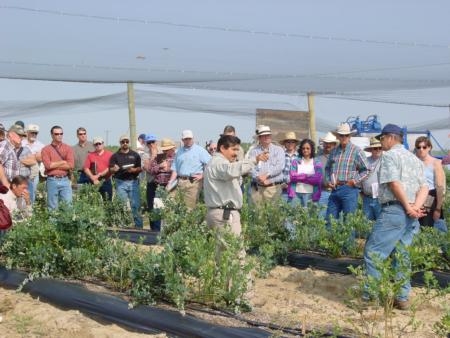
Manual Jimenez talks blueberries at the UC Kearney Agricultural Research and Extension Center last fall.
